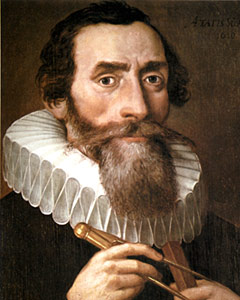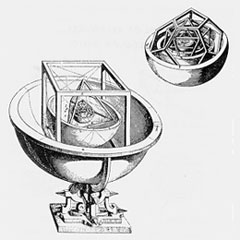
Johannes Kepler
1571 - 1630
German astronomer, first supporter of the heliocentric theory.
Author of Harmonies of the World.
First to realize the relationship between the Sun and the velocities of the planets.
Discoverer of the three laws of planetary motion.
Johannes Kepler was born premature on December 27, 1571 in Weil der Stadt, Germany. He was a sickly child and contracted smallpox when very young. Kepler went to the University of Tuebingen, a Protestant institution, where he studied theology and philosophy, as well as mathematics and astronomy. Upon completion of his formal education, he accepted a position as chair in mathematics and astronomy at Graz, Germany. In 1596, at the age of 24, Kepler published Mysterium Cosmographicum (Cosmographic Mystery). In this work he defended the Copernican theory which stated that the Sun, not the Earth, was at the center of the Solar System. Kepler was strongly influenced by the Pythagoreans, believing that the universe was being governed by geometric relationships that conform to the inscribed and circumscribed circles of the five regular polygons.

In 1598, Kepler's school in Graz was closed down by the Archduke Ferdinand of Hapsburg. He wanted to go back to Tuebingen, but they didn't want him, because of his known belief in Copernicanism. The astronomer Tycho Brahe invited Kepler to come to Prague to be his assistant. Confronted with the Catholic persecution of the Protestant minority in Graz, Kepler accepted Brahe's offer and left for Prague on January 1, 1600. When Brahe died the following year, Kepler was appointed his successor. The legacy Kepler inherited from Brahe included many accurate positional determinations of the planets, especially those of Mars. Kepler used this data to study of the true orbits of the planets. He abandoned the belief that the planets moved in perfect circles, and proved that the orbit of Mars is actually an ellipse. This, the first of Kepler's laws of planetary motion, appeared in Astronomia Nova (New Astronomy) which he published in 1609. His second law of planetary motion, also published in 1609, describes the concept of planetary velocity. His third law, published in 1619, describes the relationship between the orbital periods of the planets and their distances from the Sun. Kepler's three laws of planetary motion are as follows:
- The orbit of a planet/comet about the Sun is an ellipse with the Sun's center of mass at one focus
- A line joining a planet/comet and the Sun sweeps out equal areas in equal intervals of time
- The squares of the periods of the planets are proportional to the cubes of their semimajor axes
Kepler died in Regensburg, Germany on November 15, 1630 after a short illness. His important work would later lay the foundation for Isaac Newton's theory of gravitation. He was a crucial link between the thought of Copernicus and that of Newton, and is considered one of the most important figures in the 17th-century scientific revolution.




